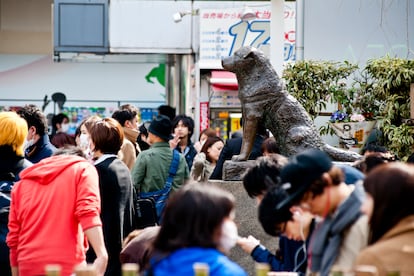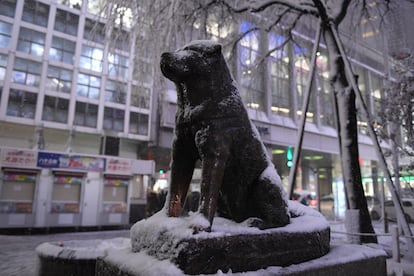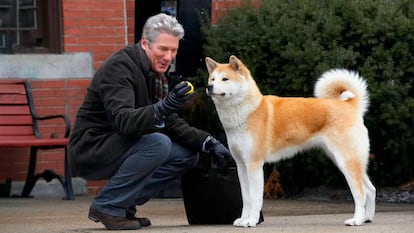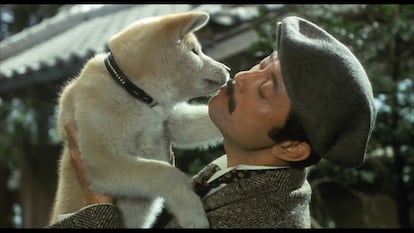Hachiko, the Japanese dog who died waiting 10 years for his owner
This year marks the 100th birthday of the puppy who waited outside Shibuya train station every day in the hope of being reunited with his deceased master

The most popular place to meet someone in Tokyo is the statue of a dog named Hachiko, who, after the death of his owner, waited for his return outside Shibuya train station for almost 10 years. The unwavering loyalty of the dog, a Japanese Akita, gave rise to an emotional story that has since been celebrated in dozens of books, manga, TV shows and at least three films. Images of the expectant-looking dog, with his right ear erect, are sold on keychains, T-shirts and adorn bus lines, labels of cookies, sauces, liqueurs and chocolates. An image of Hachiko dressed as a police officer is featured on five police cars that patrol Shibuya, and a sports shoe brand imitated the brown fur of the Akita breed to design a furry collector’s model.
This year, the town of Odate in Akita Prefecture marks the 100th birthday of the puppy that was sent by train to Hidesaburo Ueno, a professor of agriculture at what is now the University of Tokyo, by one of his former students. According to the most common version of the story, Hachiko went with Professor Ueno every day to Shibuya station when he left for university, and returned home alone. In the afternoon, he would wait for his master at the station again and they would return together.
One day in May 1925, while at university, Professor Ueno had a stroke and died. The dog, however, continued to wait for him — even after Ueno’s widow moved to another area of the city. Hachiko was adopted successively by different residents of Shibuya, and continued to wait for his deceased master until his own death, in 1935.

Given the dog’s impassive attitude and muscular build, the animal was often a nuisance to the crowd of passengers at the station. Believing him to be a stray dog, the children harassed him, climbed on his back and painted his face with ink. But the animal’s calm attitude caught the attention of the media, and in 1935 the Asahi newspaper published an article with a photo of Hachiko. The story was titled, “The Endearing Story of an Old Dog,” and talked about his “seven years of persistent waiting in Shibuya.” Following the story, many people went to meet the dog, and others sent money to the station for his food.
A group of Hachiko fans was created, and in 1934, they raised funds for a bronze monument to be erected in honor of his loyalty. Due to metal shortages during World War II, the sculpture was recycled on August 14, 1945, for military purposes. The very next day, the war ended and the metal was sent to be used for a railway line.
Three years later, in 1948, the Hachiko statue that now stands was erected in front of the station. Today, it has become a mandatory stop for those who visit Shibuya Crossing, which has been immortalized in films such as Lost in Translation (2003) and Babel (2006). At the crossing, every three minutes, eight lanes of traffic come to a stop at the traffic lights and a crowd crosses from 12 different directions.

The number of Western tourists visiting the Hachiko statue rose after the premiere of Hachi: A Dog’s Tale (2009), an American film in which actor Richard Gere plays a music teacher who adopts a stray Akita puppy. He names the dog Hachi after a Japanese character in the film explains that the character on the animal’s collar is the number eight, or hachi in Japanese. The “ko” in Hachiko is an ancient honorific title used by nobility and was added by Ueno’s students, who chose eight as their lucky number.
Those wishing to learn about the history of Hachiko in Tokyo can visit his embalmed body in the Museum of Natural Sciences, the professor’s grave in Aoyama Cemetery (which contains some of the dog’s cremated organs) and a sculpture at the University of Tokyo in which master and pet are reunited.
The most recent movie version of Hachiko’s story was released this year in China. Directed by Feng Xiaogang, it is a similar movie to the Japanese film Hachiko Monogatari (Story of Hachiko, 1987). According to sources at Shibuya City Hall, the dog’s story has no copyright and can be used freely.

Professor Keita Matsui, a well-known scholar of Shibuya history, explains that the most popular account of Hachiko is inaccurate. He explains that since Ueno lived so close to the university, he was able to walk there. According to the scholar, Ueno only took the train for long journeys that often lasted several days.
Hachiko would wait for him and, on one occasion when they were reunited, the professor was so happy to see him at the station that he showered him with affection and gave him some popular chicken skewers from a street vendor. Matsui, who is also curator of the Shibuya Folk and Literary Shirane Memorial Museum, says that this may have been repeated on other occasions, which conditioned Hachiko to wait at the station.
Matsui works relentlessly to clarify the details of the life of the famous animal, because, he jokes, “dogs cannot write, nor leave their testimonies in writing.” He explains that the Akita was historically a fighting and hunting dog, which is why some countries have restrictions on the breed.
This year, Professor Matsui will join the celebrations to mark 100 years of Hachiko, offering a lecture that promise to tell “the true story of Hachiko.”
Sign up for our weekly newsletter to get more English-language news coverage from EL PAÍS USA Edition
Tu suscripción se está usando en otro dispositivo
¿Quieres añadir otro usuario a tu suscripción?
Si continúas leyendo en este dispositivo, no se podrá leer en el otro.
FlechaTu suscripción se está usando en otro dispositivo y solo puedes acceder a EL PAÍS desde un dispositivo a la vez.
Si quieres compartir tu cuenta, cambia tu suscripción a la modalidad Premium, así podrás añadir otro usuario. Cada uno accederá con su propia cuenta de email, lo que os permitirá personalizar vuestra experiencia en EL PAÍS.
¿Tienes una suscripción de empresa? Accede aquí para contratar más cuentas.
En el caso de no saber quién está usando tu cuenta, te recomendamos cambiar tu contraseña aquí.
Si decides continuar compartiendo tu cuenta, este mensaje se mostrará en tu dispositivo y en el de la otra persona que está usando tu cuenta de forma indefinida, afectando a tu experiencia de lectura. Puedes consultar aquí los términos y condiciones de la suscripción digital.
More information
Últimas noticias
All the effects of gentrification in one corner of Mexico’s Colonia Roma
Palestinian reporter Youmna El Sayed: ‘My family told me I had to choose between being a journalist or a mother’
The new language of the workplace: Knowing how to ask AI questions is more important than using it
Russell Tovey: ‘I was advised many times not to come out, I don’t think there was many people who’d done that — and I feel really proud that I’m one of those that did’
Most viewed
- The low-cost creative revolution: How technology is making art accessible to everyone
- Christian Louboutin: ‘Young people don’t want to be like their parents. And if their parents wear sneakers, they’re going to look for something else’
- US sanctions against jailed cartel leader ‘El Marro’ highlight Mexico’s lack of control over its prisons
- Liset Menéndez de la Prida, neuroscientist: ‘It’s not normal to constantly seek pleasure; it’s important to be bored, to be calm’
- Cartels in Mexico take a leap forward with narco-drones: ‘It is criminal groups that are leading the innovation race’










































